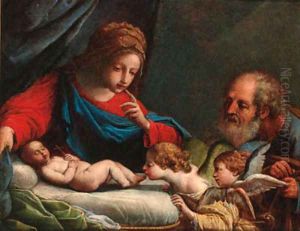Pietro De Pietri Paintings
Pietro De Pietri, born in 1663 and passing away in 1716, was an Italian painter active during the Baroque period, a time characterized by dramatic expression and elaborate decoration. His life and career were predominantly centered in Rome, where the Baroque style flourished under the patronage of the church and the aristocracy. De Pietri's contributions to art are reflective of the period's fascination with light, shadow, and dynamic composition, though he is perhaps less well-known than some of his contemporaries.
De Pietri's artistic journey is intertwined with the rich cultural and artistic milieu of Rome in the late 17th and early 18th centuries. He was a part of a vibrant community of artists who were exploring new ways of expressing religious and mythological themes, imbuing them with emotional depth and visual splendor. His works, though not as widely recognized today, were appreciated in his time for their devotion to the Baroque ethos, with an emphasis on the dramatic interplay of light and dark, and a focus on narrative intensity.
Throughout his career, Pietro De Pietri contributed to the decoration of various churches and palaces in Rome and its surroundings. His religious paintings, which often depicted scenes from the life of Christ, the Virgin Mary, and the saints, were known for their vivid portrayal of divine and mystical experiences. De Pietri's ability to convey the spiritual fervor and the theatricality of religious narratives made him a valuable contributor to the artistic projects of his time.
Despite the lack of extensive documentation on his life compared to more renowned artists of his era, De Pietri's work continues to be of interest to art historians and enthusiasts of the Baroque period. His paintings, with their characteristic Baroque qualities, offer insight into the diverse approaches and styles that flourished in Rome during this vibrant period of art history. Pietro De Pietri's legacy, while modest in comparison to giants like Caravaggio or Bernini, represents an important facet of the rich tapestry of Baroque art.
